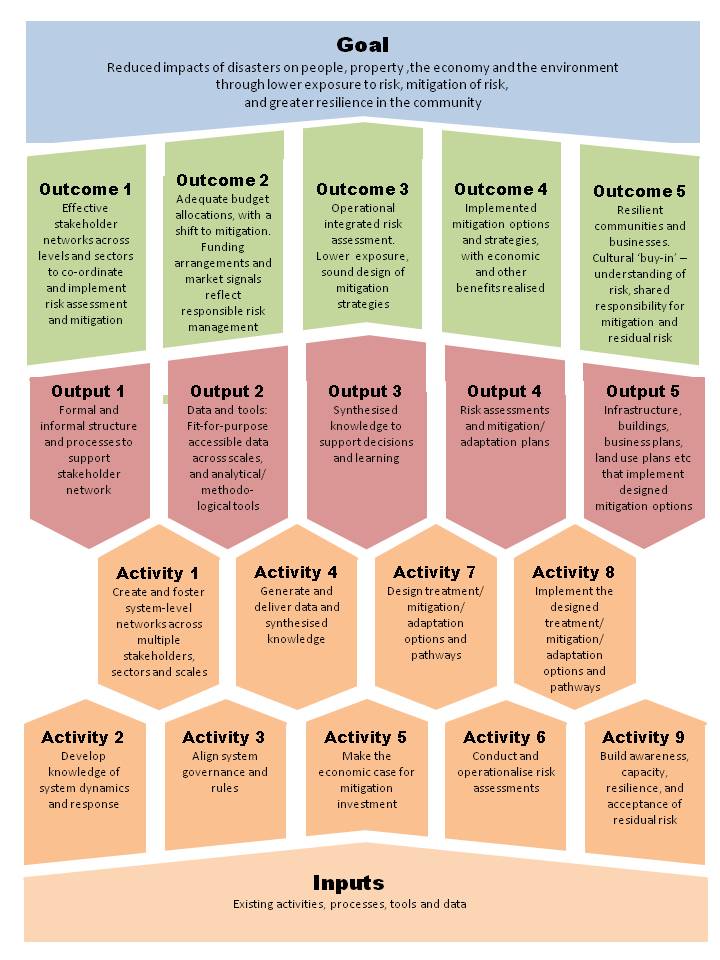Key findings on Disaster Resilience and Mitigation
Key findings of the stakeholder systems analysis
- Interviewees expressed a wide range of needs and influence pathways – a mix of formal rules (policy, legislation, funding arrangements), and other ‘soft’ influences (incentives, information, awareness, co-operation etc.).
- Most interviewees expressed the need for a change in most in parts of the system, but particularly in those parts which adjoined those closest to their own areas of operation or influence.
- This reinforced the view put forward in the Productivity Commission report – that the whole system needs consideration, and perfecting interventions in one part only is unlikely to be successful.
- There were perceived barriers to action occurring throughout the system, and they are often interdependent.
- Therefore there is a need to seek critical leverage points throughout the stakeholder system and work to enhance them simultaneously.

Systems view of the stakeholder network related to emergency management. The report has a more detailed diagram and description of the network.
Key findings from the ‘map of needs’ (or ‘theory of change’)
- The interviews provided long list of expressed needs, disparate in nature, and scattered on maturity spectrum for effective disaster risk mitigation. Therefore, we used information from the interviews, policy documents and technical reports, and the literature to distil a long-term goal, and a set of Activities, Outputs, and Outcomes.
- The nine gaps identified in the risk assessment process were used to specify nine activities to address the gaps. The expressed needs from the interviews were logically mapped into the discrete, unique but interlinked units of Activities or Outputs to create a sound basis to prioritise activities that build capability, develop processes, tools and data and synthesise knowledge in a critical pathway to reaching the long-term goal

Overarching ‘map of needs’ (or ‘theory of change’), building on the base of existing activities, processes, tools and data as Inputs, with a comprehensive set of Activities, Outputs and Outcomes to support achieving the long-term goal of disaster mitigation and resilience. There are many feedbacks between the set of proposed Activities, and the Outputs i.e. there is not a direct one to one mapping: the set of Activities and Outputs will feed into Outcomes and ultimately the long-term goal.
Key findings from the stocktake and gap analysis of tools, processes and data with respect to the the risk management process
- Analytical tools and data are only useful if they are deployed within effective institutional processes.
- There was a mismatch in the interviewees’ priorities for tools and processes with respect to risk mitigation:
- Most extant tools and processes in the risk definition parts of the risk assessment process.
- Most expressed needs are in the solutions area, where there are few operational tools available although there are several under development (See Figure 4).
- The generic risk management process provided a useful analytical framework for stocktaking the existing and desired tools and processes. Nine key gaps were identified, of which five were in the overarching ‘systems’ area. These nine gaps fed directly into the ‘map of needs’.
- There were differences in the challenges for applying risk mitigation tools across scale of application (local through to national) in terms of number of stakeholders, the types of decisions, governance and decision making processes, complexity of risk treatments and adaptations, and the data and information requirements. A different set of challenges arises from cross-scale interactions .

Applying a risk assessment at different scales has different challenges at each scale, and across scales
